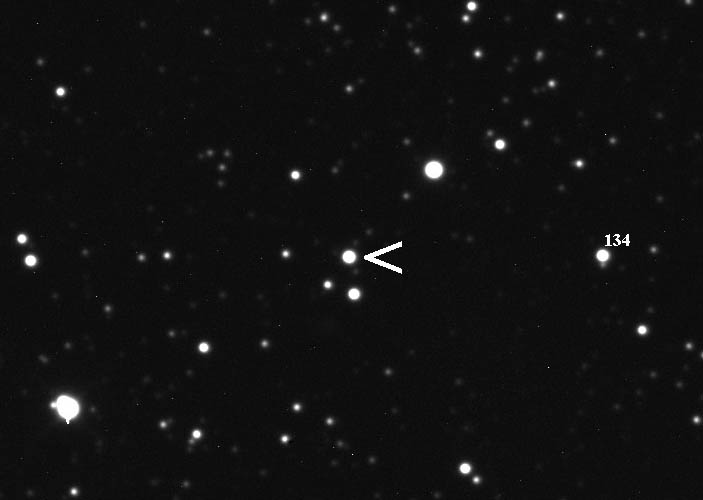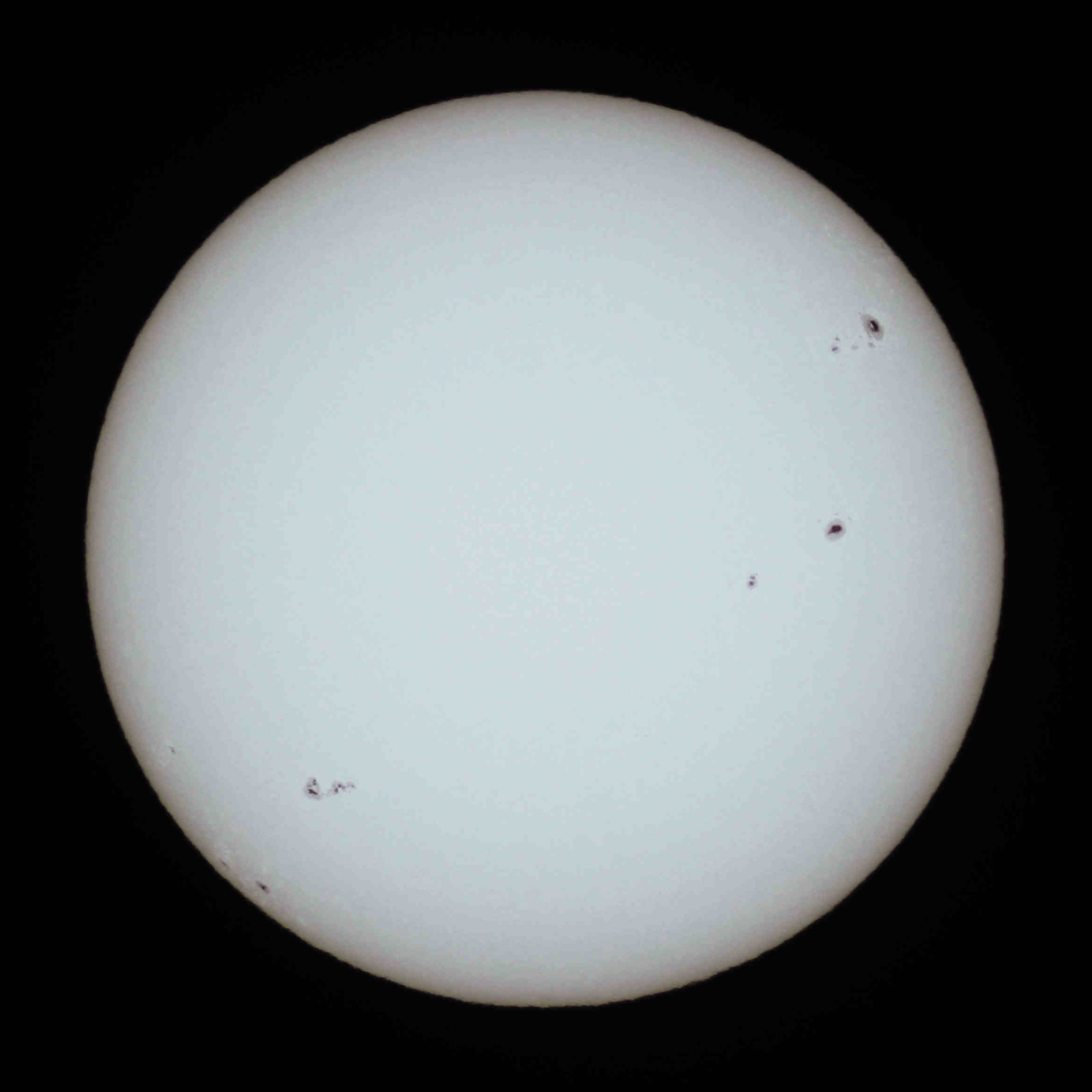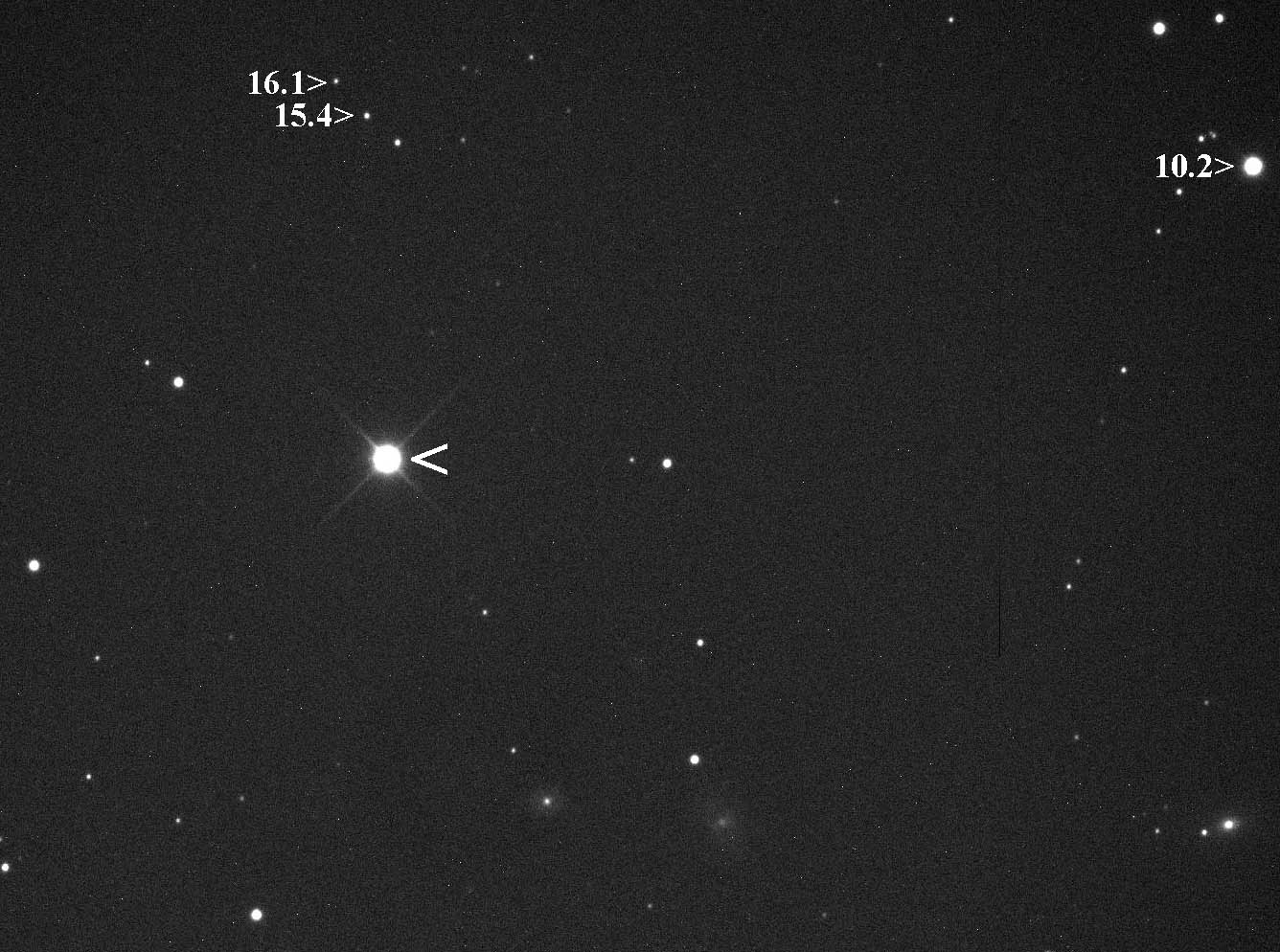|
Z Camelopardalis
Z Camelopardalis (Z Cam) is a cataclysmic variable star system in the northern constellation of Camelopardalis. It has an apparent visual magnitude which varies between 9.8 and 14.5. This system is the prototype star for the family of Z Camelopardalis variable stars: dwarf novae with standstills at a brightness intermediate between their maxima and minima. It may have been the " guest star" that was recorded by Chinese astrologers in the autumn of 77 BCE, but a 2024 study argues that this guest star was likely a comet, while one observed in 369 CE may have been Z Camelopardalis. Z Camelopardalis was discovered photographically in 1904 by Henry Park Hollis during work for the Astrographic Catalogue. It is surrounded by an extensive shell thought to have been ejected in a nova explosion, the largest known of its type. The size and expansion of this shell sets a firm lower limit since the last eruption of at least 220 years. Gallery File:Z Camelo ... [...More Info...] [...Related Items...] OR: [Wikipedia] [Google] [Baidu] |
Z Camelopardalis Variable Stars
A dwarf nova (pl. novae), or U Geminorum variable, is one of several types of cataclysmic variable star, consisting of a close binary star system in which one of the components is a white dwarf that accretes matter from its companion. Dwarf novae are dimmer and repeat more often than "classical" novae. Overview The first one to be observed was U Geminorum in 1855; however, the mechanism was not known until 1974, when Brian Warner showed that the nova is due to the increase of the luminosity of the accretion disk. They are similar to classical novae in that the white dwarf is involved in periodic outbursts, but the mechanisms are different. Classical novae result from the fusion and detonation of accreted hydrogen on the primary's surface. Current theory suggests that dwarf novae result from instability in the accretion disk, when gas in the disk reaches a critical temperature that causes a change in viscosity, resulting in a temporary increase in mass flow through the disc, whi ... [...More Info...] [...Related Items...] OR: [Wikipedia] [Google] [Baidu] |
Camelopardalis
Camelopardalis is a large but faint constellation of the northern sky representing a giraffe. The constellation was introduced in 1612 or 1613 by Petrus Plancius. Some older astronomy books give Camelopardalus or Camelopardus as alternative forms of the name, but the version recognized by the International Astronomical Union matches the genitive form, seen suffixed to most of its brighter stars. Etymology First attested in English in 1785, the word ''camelopardalis'' comes from Latin, and it is the romanization of the Greek "καμηλοπάρδαλις" meaning "giraffe", from "κάμηλος" (''kamēlos''), "camel" + "πάρδαλις" (''pardalis''), "spotted", because it has a long neck like a camel and spots like a leopard. Features Stars Although Camelopardalis is the 18th largest constellation, it is not a particularly bright constellation, as the brightest stars are only of fourth magnitude. In fact, it only contains four stars brighter than magnitude 5.0. * α Cam ... [...More Info...] [...Related Items...] OR: [Wikipedia] [Google] [Baidu] |
Dwarf Novae
A dwarf nova (pl. novae), or U Geminorum variable, is one of several types of cataclysmic variable star, consisting of a close binary star system in which one of the components is a white dwarf that accretes matter from its companion. Dwarf novae are dimmer and repeat more often than "classical" novae. Overview The first one to be observed was U Geminorum in 1855; however, the mechanism was not known until 1974, when Brian Warner showed that the nova is due to the increase of the luminosity of the accretion disk. They are similar to classical novae in that the white dwarf is involved in periodic outbursts, but the mechanisms are different. Classical novae result from the fusion and detonation of accreted hydrogen on the primary's surface. Current theory suggests that dwarf novae result from instability in the accretion disk, when gas in the disk reaches a critical temperature that causes a change in viscosity, resulting in a temporary increase in mass flow through the disc, whi ... [...More Info...] [...Related Items...] OR: [Wikipedia] [Google] [Baidu] |
G-type Main-sequence Stars
A G-type main-sequence star (spectral type: G-V), also often, and imprecisely, called a yellow dwarf, or G star, is a main sequence, main-sequence star (luminosity class V) of stellar classification, spectral type G. Such a star has about 0.9 to 1.1 solar masses and an effective temperature between about . Like other main-sequence stars, a G-type main-sequence star converts the Chemical element, element hydrogen to helium in its core by means of nuclear fusion. The Sun, the star in the center of the Solar System to which the Earth is gravitationally bound, is an example of a G-type main-sequence star (G2V type). Each second, the Sun fuses approximately 600 million tons of hydrogen into helium in a process known as the proton–proton chain (4 hydrogens form 1 helium), Mass–energy equivalence, converting about 4 million tons of matter to energy. Besides the Sun, other well-known examples of G-type main-sequence stars include Alpha Centauri, Tau Ceti, and 51 Pegasi. Description Th ... [...More Info...] [...Related Items...] OR: [Wikipedia] [Google] [Baidu] |
Research In Astronomy And Astrophysics
''Research in Astronomy and Astrophysics'' is a monthly peer-reviewed scientific journal covering all branches of astronomy and astrophysics. It was established in 1981 as ''Acta Astrophysica Sinica'' and published in Chinese. It was renamed ''Chinese Journal of Astronomy and Astrophysics'' in 2001, switching to publication in English and restarting volume numbering. It obtained its current name in 2009. The journal is published by IOP Publishing, on behalf of the National Astronomical Observatory of China and the Chinese Astronomical Society. The editor-in-chief is Jingxiu Wang (National Astronomical Observatory of China). According to the ''Journal Citation Reports'', the journal has a 2023 impact factor The impact factor (IF) or journal impact factor (JIF) of an academic journal is a type of journal ranking. Journals with higher impact factor values are considered more prestigious or important within their field. The Impact Factor of a journa ... of 1.8. References Ex ... [...More Info...] [...Related Items...] OR: [Wikipedia] [Google] [Baidu] |
Astronomy Reports
''Astronomy Reports'' (Russian: ''Астрономический журнал'', ''Astronomicheskii Zhurnal''), is a Russian, monthly, peer reviewed, scientific journal. This journal tends to focus its publishing efforts on original research regarding astronomical topics. Other types of reporting are also included such as chronicles, proceedings of international conferences, and book reviews. Founded in 1924, it is described as the most prominent astronomy journal during the age of the Soviet Union. Originally a print version, it is also available online. The editor-in-chief was Alexander A. Boyarchuk, Institute of Astronomy of the Russian Academy of Sciences, Moscow, Russia. Former title This journal, currently titled "''Astronomy Reports''", continues with the same Russian title as when it was known in English as ''Soviet Astronomy''. The former ''Soviet Astronomy'' shares exactly the same Russian name as this journal, exactly the same print issn, but the US Library of Congr ... [...More Info...] [...Related Items...] OR: [Wikipedia] [Google] [Baidu] |
Ultraviolet
Ultraviolet radiation, also known as simply UV, is electromagnetic radiation of wavelengths of 10–400 nanometers, shorter than that of visible light, but longer than X-rays. UV radiation is present in sunlight and constitutes about 10% of the total electromagnetic radiation output from the Sun. It is also produced by electric arcs, Cherenkov radiation, and specialized lights, such as mercury-vapor lamps, tanning lamps, and black lights. The photons of ultraviolet have greater energy than those of visible light, from about 3.1 to 12 electron volts, around the minimum energy required to ionize atoms. Although long-wavelength ultraviolet is not considered an ionizing radiation because its photons lack sufficient energy, it can induce chemical reactions and cause many substances to glow or fluoresce. Many practical applications, including chemical and biological effects, are derived from the way that UV radiation can interact with organic molecules. The ... [...More Info...] [...Related Items...] OR: [Wikipedia] [Google] [Baidu] |
Nova
A nova ( novae or novas) is a transient astronomical event that causes the sudden appearance of a bright, apparently "new" star (hence the name "nova", Latin for "new") that slowly fades over weeks or months. All observed novae involve white dwarfs in close binary systems, but causes of the dramatic appearance of a nova vary, depending on the circumstances of the two progenitor stars. The main sub-classes of novae are classical novae, recurrent novae (RNe), and dwarf novae. They are all considered to be cataclysmic variable stars. Classical nova eruptions are the most common type. This type is usually created in a close binary star system consisting of a white dwarf and either a main sequence, subgiant, or red giant star. If the orbital period of the system is a few days or less, the white dwarf is close enough to its companion star to draw accreted matter onto its surface, creating a dense but shallow atmosphere. This atmosphere, mostly consisting of hydrogen, is heated by ... [...More Info...] [...Related Items...] OR: [Wikipedia] [Google] [Baidu] |
Astrographic Catalogue
The Carte du Ciel (; literally, 'Map of the Sky') and the Astrographic Catalogue (or Astrographic Chart) were two distinct but connected components of a massive international astronomical project, initiated in the late 19th century, to catalogue and map the positions of millions of stars as faint as 11th or 12th magnitude. Twenty observatories from around the world participated in exposing and measuring more than 22,000 (glass) photographic plates in an enormous observing programme extending over several decades. Despite, or because of, its vast scale, the project was only ever partially successful – the Carte du Ciel component was never completed, and for almost half a century the Astrographic Catalogue part was largely ignored. However, the appearance of the Hipparcos Catalogue in 1997 has led to an important development in the use of this historical plate material. Origins and goals A vast and unprecedented international star-mapping project was initiated in 1887 by P ... [...More Info...] [...Related Items...] OR: [Wikipedia] [Google] [Baidu] |
Guest Star (astronomy)
In Chinese astronomy, a guest star () is a star which has suddenly appeared in a place where no star had previously been observed and becomes invisible again after some time. The term is a literal translation from Chinese astronomy#Early history, ancient Chinese astronomical records. Modern astronomy recognizes that guest stars are manifestations of cataclysmic variable stars: novae and supernovae. The term "guest star" is used in the context of ancient records, since the exact classification of an astronomical event in question is based on interpretations of old records, including inference, rather than on direct observations. In ancient Chinese astronomy, guest stars were one of the three types of highly transient objects (bright heavenly bodies). The other two were comets with tails () and comets without tails (), with the former term being used for all comets in modern astronomy. The earliest Chinese record of guest stars is contained in ''Han Shu'' (漢書), the history o ... [...More Info...] [...Related Items...] OR: [Wikipedia] [Google] [Baidu] |
Dwarf Nova
A dwarf nova (pl. wiktionary:nova, novae), or U Geminorum variable, is one of several types of cataclysmic variable star, consisting of a close binary star system in which one of the components is a white dwarf that accretion disk, accretes matter from its companion. Dwarf novae are dimmer and repeat more often than "classical" novae. Overview The first one to be observed was U Geminorum in 1855; however, the mechanism was not known until 1974, when Brian Warner (astronomer), Brian Warner showed that the nova is due to the increase of the luminosity of the accretion disk. They are similar to classical novae in that the white dwarf is involved in periodic outbursts, but the mechanisms are different. nova, Classical novae result from the fusion and detonation of accreted hydrogen on the primary's surface. Current theory suggests that dwarf novae result from instability in the accretion disk, when gas in the disk reaches a critical temperature that causes a change in viscosity, result ... [...More Info...] [...Related Items...] OR: [Wikipedia] [Google] [Baidu] |


